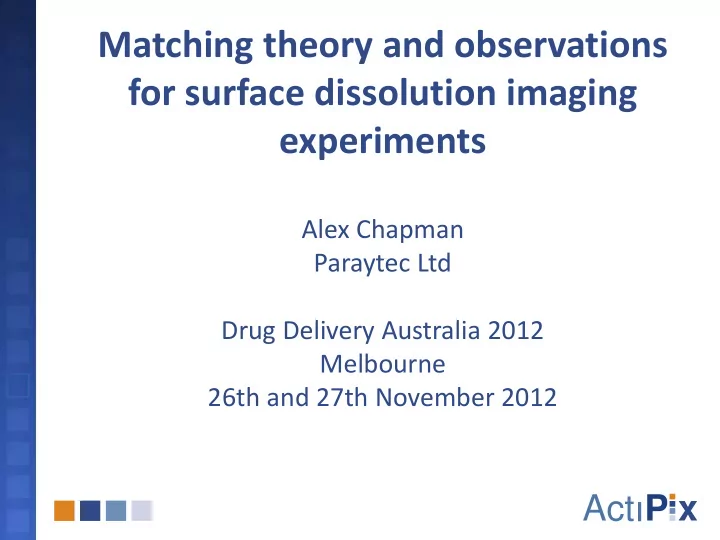

Matching theory and observations for surface dissolution imaging experiments Alex Chapman Paraytec Ltd Drug Delivery Australia 2012 Melbourne 26th and 27th November 2012 Act P x
How does the SDI300 work? Act P x
Interrogating the data Solubility and Diffusion Zone (above the sample surface) / IDR Zone (downstream) Act P x
Theory Act P x
Theory for dissolution rate 𝑒𝑛 𝑒𝑢 = 𝐵 𝐸 𝑒 𝐷 𝑡 −𝐷 𝑐 Where: D = diffusion coefficient A = surface area, d = diffusion layer thickness, C s = solubility, C b = bulk concentration. Act P x
Fixed values 𝑒𝑛 𝑒𝑢 = 𝐵 𝐸 𝑒 𝐷 𝑡 −𝐷 𝑐 Where: D = diffusion coefficient A = surface area, d = diffusion layer thickness, C s = solubility, C b = bulk concentration. The SDI300 is a flow through ‘in sink’ system, so 𝐷 𝑐 is 0 Our sample compress has a fixed surface area Act P x
Overall Dissolution Rate 𝑒𝑛 𝑒𝑢 = 𝐵 𝐸 𝑒 𝐷 𝑡 −𝐷 𝑐 Where: D = diffusion coefficient A = surface area, d = diffusion layer thickness, C s = solubility, C b = bulk concentration. The calculation of dm / dt gives us the dissolution rate, this is done by measurement of UV absorbance in the IDR zone in our patented UV imaging detector Act P x
Interrogating the data Solubility and Diffusion Zone (above the sample surface) / IDR Zone (downstream) Act P x
Digging deeper 𝑒𝑛 𝑒𝑢 = 𝐵 𝐸 𝑒 𝐷 𝑡 −𝐷 𝑐 Where: D = diffusion coefficient A = surface area, d = diffusion layer thickness, C s = solubility, C b = bulk concentration. For diffusion upwards from the surface under zero flow conditions, we can calculate the diffusion coefficient, by examining how the concentration profile changes as a function of time: ( C - C b )/( C s - C b ) = erfc[ z /(4 Dt ) 1/2 ] This is readily done by plotting, for a fixed absorbance, z versus t 1/2 Act P x
Interrogating the data Solubility and Diffusion Zone (above the sample surface) / IDR Zone (downstream) Act P x
Add in solubility 𝑒𝑛 𝑒𝑢 = 𝐵 𝐸 𝑒 𝐷 𝑡 −𝐷 𝑐 Where: D = diffusion coefficient A = surface area, d = diffusion layer thickness, C s = solubility, C b = bulk concentration. Concentration of the drug at the surface, which equals the solubility if dissolution is not rate limiting, is determined from the measured absorbance at the surface. The extinction coefficient is required, and if not known this can be measured by flowing calibrating solutions with known concentrations of the drug through the system. Act P x
Ketoprofen surface concentration and solubility Uses observed data for ketoprofen dissolving in water at room temperature (flow rate 0.2 mL/min), extinction coefficient 1580 m 2 mol -1 , and molecular weight 254.3. 𝐷 𝑡 = 0.12 mg/mL Act P x
Interrogating the data Solubility and Diffusion Zone (above the sample surface) / IDR Zone (downstream) Act P x
Diffusion layer? 𝑒𝑛 𝑒𝑢 = 𝐵 𝐸 𝑒 𝐷 𝑡− 𝐷 𝑐 Where: D = diffusion coefficient A = surface area, d = diffusion layer thickness, C s = solubility, C b = bulk concentration. Act P x
What did we find? We found the overall Intrinsic Dissolution Rate We found the Diffusion Coefficient We found the Drug Solubility And a lot more besides: Diffusion layer thickness Wettability issues Sample swelling Sample break down Is the dissolution rate diffusion limited? Test by changing flow and shear rates Act P x
What did it take? 20 minutes 10 mL of media (including BioRelevant and detergents) 5 mg sample Act P x
Observations Act P x
Matching observation against theory • Agreement is good for atenolol and ketoprofen dissolving as neutrals , but theoretical rates based on equilibrium solubilities as the charged forms grossly overestimates observed dissolution rates. Act P x
Conclusions • Good agreement between observations and theory is found when the form of the API is the same in both solid and solution. • The key parameter in convective diffusion theory is the concentration at the surface . Other variables (diffusion coefficient, flow rate) have much smaller influence on the predicted dissolution rate. • This approach combining theory and measurement is also expected to be of value in looking at blends of APIs with excipients designed for controlled release. Further work Uniquely, the SDI300 allows measurement of UV absorbance and hence concentration of the API in the surface layer as well as the dissolution rate. This is currently being investigated further. Act P x
Act P x
Recommend
More recommend